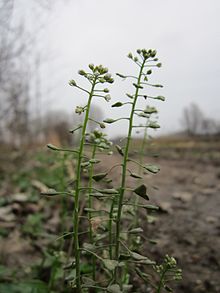Capsella bursa-pastoris
Capsella bursa-pastoris is an annual herbaceous phanerogamous species native to eastern Europe and Asia Minor, although naturalized in many parts of the world, especially in regions of cold weather and considered a common grass.
Description
This herbaceous plant, with no more than 40 cm, is unmistakable, when you see its fruits, a defining characteristic within the family, as shown in the photograph (highly enlarged). Its small flower, barely 4 mm, from the end of winter and almost the whole year (if it is not very dry) is white with small reddish lines, the leaves are arranged in a basal rosette. Its heart-shaped fruits (silicula) resemble the shape of a bag, hence the common name of zurrroncillo or shepherd's bag (although there are some doubts about it).
The Capsella bursa-pastoris, or shepherd's purse, is a plant credited with being carnivorous. It is considered a unique protocarnivorous plant, as it can only capture its prey during one period of its life cycle. The seeds of the plant, when moistened, secrete a viscous liquid (myxospermia) that actively attracts and kills its prey. There is also evidence for protease activity and nutrient uptake. The only unexplored carnivorous criteria is to what extent the plant benefits from its carnivorous adaptations.
Uses
In 1542, commenting on Dioscorides' De materia medica, the doctor Andrea Mattioli da Siena recommended Capsella bursa-pastoris "against hemorrhages and heavy blood loss& #3. 4;. In ancient Castilla (Spain) it is known of its use by women to stop bleeding caused by the menstrual cycle.
Although its taste is very unpleasant in infusion, currently, certain commercial naturopathic medicine houses use it as a symptomatic treatment of menorrhagia and metrorrhagia and are cultivated for this purpose.
It is also popularly known as: pan y quesillo. Known since ancient times, it was widely used in the Middle Ages. Cited by Dioscorides as a hemostatic.
- The decoction of the plant is used to treat digestive conditions (diarrhea, dysentery), tuberculosis, dysmenorrea, hypertension, hematuria bleeding, metrorrhage and nephritis.
- Topic and oral treatment is used to treat ulcers, fibroids, tumors and various forms of cancer, inflammation and irritation of mucosa; dry leaves powder is used to dry wounds. Fresh plant stain is used to regulate menstrual disorders, cystitis, urolitiasis and diarrhea.
There are no references to its use in gardening.
Diseases
The white rust (Albugo candida) often parasitizes on shepherd's sack and other cruciferous plants. Plasmodiophora brassicae, the agent of collard greens, also parasitizes the shepherd's sack.
Taxonomy
Capsella bursa-pastoris was described by Medik. ex L. and published in Pflanzen-Gattungen 85. 1792.
- Varieties
- Capsella bursa-pastoris var. arachnoidea Hus
- Capsella bursa-pastoris var. concava Almq.
- Capsella bursa-pastoris var. integraifolia DC.
- Capsella bursa-pastoris var. orbicularis Hus
- Capsella bursa-pastoris var. rubriflora Muschl.
- Capsella bursa-pastoris var. setchelliana Hus
- Capsella bursa-pastoris var. simplex Hus
- Sinonimia
- Capsella hyrcana Grossh.
- Capsella gracilis Gren.
- Capsella polymorpha Cav.
- Capsella rubella Reut.
- Thlaspi bursa-pastoris var. microcarpum Loscos in Loscos & J.Pardo
- Thlaspi bursa-pastoris L.
Basionym
Thlaspi bursa-pastoris L. (first collected in Species Plantarum 1753)
Common names
- shepherd's bag, shepherd's bag, bottle, slipper, cucliyo, devanaera, devanaeras, herba dos dentes, crab herb, charcoal grass, ham, syrup, white syrup, jarilla, mustard, wild mustard, mustard, white straw, pamplinas, shepherd's bread, pork
Contenido relacionado
Classification of plants
Special botany
Aegopogon



